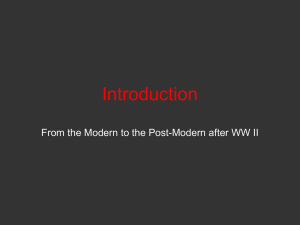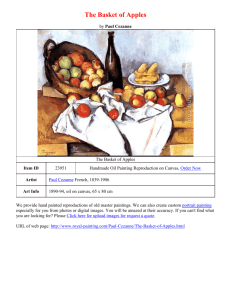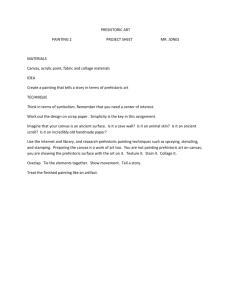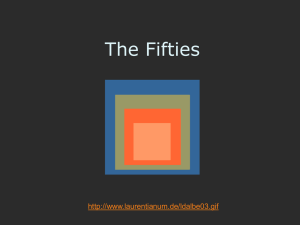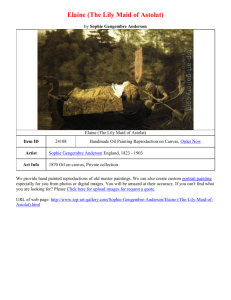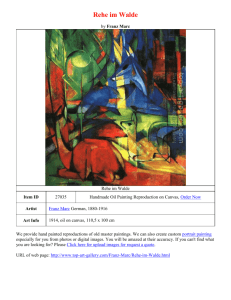Fifties, Other Tendencies - California State University, Sacramento
advertisement
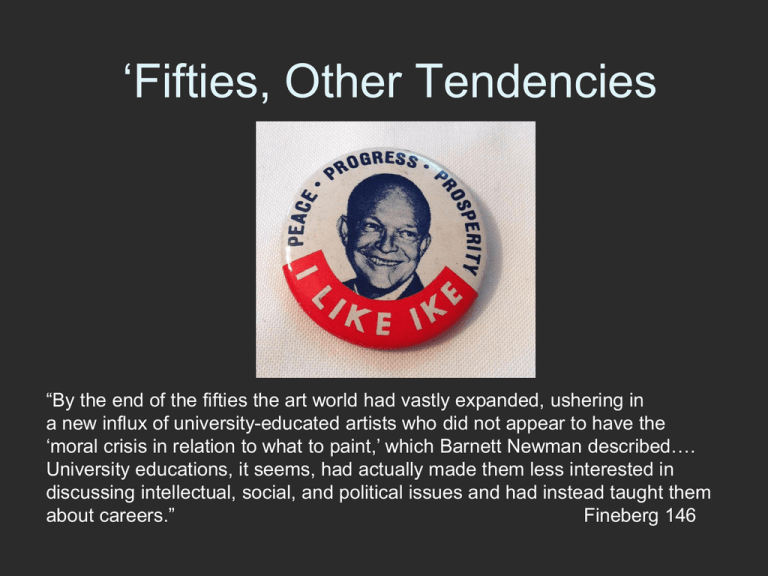
‘Fifties, Other Tendencies “By the end of the fifties the art world had vastly expanded, ushering in a new influx of university-educated artists who did not appear to have the ‘moral crisis in relation to what to paint,’ which Barnett Newman described…. University educations, it seems, had actually made them less interested in discussing intellectual, social, and political issues and had instead taught them about careers.” Fineberg 146 Helen Frankenthaler (US, b. 1928), Mountains and Sea, 1952, charcoal and oil on unprimed canvas, 7’2” x 9’9” “Post-Painterly abstraction,” “Color Field Painting” (late “Modernist” painting) http://www.youtube.com/watch?v=PsoaxUcwp3s Helen Frankenthaler in 1950 on seeing Pollock's paintings, Autumn Rhythm and Lavender Mist: “It was as if I suddenly went to a foreign country and didn't know the language, but had read enough, and had a passionate interest, and was eager to live there. I wanted to live in this land. I had to live there, and master the language." Photograph: Jackson Pollock (far left) with Lee Krasner (far right), Clement Greenberg, unidentified child, and Helen Frankenthaler at the beach near Springs, Long Island. Unidentified photographer, ca. 1952. Helen Frankenthaler, Magic Carpet, 1964, 96 X 68 inches, acrylic on canvas Color Field Painting Morris Louis (US, 1912-1962), Tet, 1958, synthetic polymer on canvas, 8 x 13ft. Influence of Frankenthaler (1953 visit) and Clement Greenberg Jules Olitski (Ukrainian-US, 1922-2007) (right), Draky 1966, and (left) Comprehensive Dream, both are 120 x 92 inches, acrylic on canvas. Greenbergian Formalism – Color Field – Post-Painterly Abstraction Kenneth Noland (US, 1924-2010) Turnsole, 1961, synthetic polymer paint on unprimed canvas, 7' 10 1/8" x 7' 10 1/8“ “Noland made his first completely individual statement when, as he said, he discovered the center of the canvas.” Visitor in front of Turnsole in 2004 Josef Albers (German-US,1888 -1976) selections from series, Homage to the Square: (top right) Ascending 1953; and (lower right) Atuned, 1958, both are oil on masonite. Émigré Bauhaus master, influential teacher at Black Mountain College (1933-1949) and Yale University (19491958) Albers’ 1963 Interaction of Color, a classic pedagogical text http://www.laurentianum.de/ldalbe03.gif Ellsworth Kelly (US b. 1924), Red Blue Green, 1963, c. 84 x 136 inches, oil on canvas, Museum of Contemporary Art San Diego Ellsworth Kelly (b. 1923), installation at the Broad museum of contemporary art, Los Angeles, February, 2008. Grace Hartigan (US, 19222008), Summer Street, 1956, oil on canvas Grace Hartigan, New England October, 1957, oil on canvas 68 x 83 in. Albright-Knox Art Gallery, Buffalo, N.Y. New York School poet, Frank O’Hara and Grace Hartigan published together in Folder, a independent magazine (New York 1953-1956) (left, at table) Frank O’Hara, Larry Rivers, Grace Hartigan (and David Smith standing at far left) at the Five Spot, NYC 1957 (right) Larry Rivers, Jack Kerouac, David Amram, Allen Ginsberg, Gregory Corso “New York School”poets and Beat poets Larry Rivers (US painter, sculptor, printmaker, poet and musician,1923-2002) Portrait of Frank O’Hara,1954, o/c, 97"/ 53” Rivers and O’Hara at work on collaborative lithograph, 1958 Larry Rivers, Double Portrait of Berdie, oil on canvas, 1954 Larry Rivers, The Greatest Homosexual, 1964, oil, collage, pencil and colored pencil on canvas, 80 X 61 in. Hirshhorn, DC Alice Neel (Pennsylvania US, 1900-1984 active NYC), (right) Joe Gould, oil on canvas, 1933, 39 x 31 in. Tate Modern, London (left) Pregnant Maria, oil on canvas, 1964, 32x47 in., private collection http://www.aliceneel.com/home/ Robert Frank (Swiss-US, b. 1924) Drug Store – Detroit, 1955-56, from The Americans Robert Frank, Trolley, New Orleans, 1955, from The Americans Robert Frank, The Parade, Hoboken, New Jersey, 1955, from The Americans 1959 independent artist film said to define the Beat generation, Pull My Daisy, was directed by Robert Frank and Alfred Leslie, narrated by Jack Kerouac and featured Allen Ginsberg and New York Figurative painters, Larry Rivers and Alice Neel http://www.veoh.com/watch/v6406893Mx Qs3zEx “I saw the best minds of my generaton destroyed by madness, starving hysterical naked…burned alive in their innocent flannel suits on Madison Avenue…or run down by the drunken taxicabs of Absolute Reality.” from poem “Howl” by Allen Ginsberg, 1955 Clyfford Still (US, 1904-1980), 1951 (right) Mark Rothko,1952 Taught at the California School of Fine Art (now San Francisco Art Institute) Abstract Expressionist influence on Bay Area painters: David Park, Elmer Bischoff, and Richard Diebenkorn David Park (US, 1911-1960), (left) Seated Man in a T-Shirt, 1958, SFMoMA (right) Art, Nature & Civilization, 1934, WPA Mural, San Francisco, Hayes Valley (below right) Three Violinists and Dancers, 1935-37 WPA Social Realism Bay Area Figurative Expressionism David Park, Torso (detail, right) 1959, SFMoMa "David was keen about Abstract Expressionism as long as it had the immediacy and tangibility and goopy sensuous arrangement of forms, but when it got into the very serious 'views of the cosmos' he didn't go along with that." (Elmer Bischoff) Richard Diebenkorn, (Born Portland, Oregon, active Bay Area, 1922-1993), Coffee, 1958, oil on canvas. Bay Area Figuration Compare: (left) Edward Hopper, Morning Sun, oil on canvas, 1952 (right) Richard Diebenkorn, Woman in Profile, oil on canvas, 1958 Richard Diebenkorn, Cityscape I, (Landscape No. 1), 1963, oil on canvas, 6o × 5o in, San Francisco Museum of Modern Art Richard Diebenkorn, Ocean Park No. 54, 1972, oil on canvas, SFMOMA Elmer Bischoff (US, 1916 -1991), Two Figures on the Seashore, 1957, o/c (right) Orange Sweater, 1955. Bay Area Figuration Cover of the influential anthology of writings by Dada artists and writers edited by Abstract Expressionist painter, Robert Motherwell, 1951 NEO-DADA (In 1951 “painter” was a synonym for “artist.”) (left) Italian Futurist music event, 1913, The music of chance and “noise,” including the sounds of urban life; (center) Hugo Ball performing Dada poem at the Cabaret Voltaire in Zurich, Switzerland, 1916 Historical sources for Neo-Dada of the 1950s New York Dada In Advance of a Broken Arm by Marcel Duchamp, 1915 Jean Arp, Collage Arranged According to the Laws of Chance, 1916. Dada John Cage (US, 1912-1992) early 1950s, prepared piano, aleatory (chance) music, Zen Buddhism and the I Ching (Book of Changes) "In the nature of the use of chance operations is the belief that all answers answer all questions.“ Don’t try to change the world, you’ll only make it worse. -Cage Allan Kaprow (US, 1927-2006), 18 Happenings in 6 Parts, Reuben Gallery, NYC, 1959 Art News, October 1958, published Allan Kaprow’s article, "The Legacy of Jackson Pollock,” which was an analysis of Pollock's work and a meditation on the meaning of Pollock’s death (1956) for the painting avant-garde. LACE (Los Angeles Contemporary Exhibitions) and artist Steve Roden reinvented 18 Happenings in 6 Parts (1959/2008) over five nights from April 22 through April 26, 2008. Allan Kaprow, Yard, Martha Jackson Gallery, NYC 1961; compare (right) Pollock painting, 1950 From “Action Painting” to performance art. Young artists of today need no longer say, "I am a painter" or "a poet" or "a dancer." They are simply "artists." All of life will be open to them. - Allan Kaprow, “The Legacy of Jackson Pollock,” 1958 (Artnews) Allan Kaprow, photograph from Household, a Happening commissioned by Cornell University, 1964. Open link below for 2008 re-enactment s of Happenings for the MoCA Los Angeles Allan Kaprow retrospective http://www.moca.org/kaprow/index.php/category/household/ Jiro Yoshihara (Japan 1905-1972), Painting, 1960 founded Gutai (Gutai Bijutsu Kyokai - Concrete Art Association) in Osaka in 1954 When Jiro Yoshihara died in 1972 the Gutai Art Association was dissolved. Shozo Shimamoto (Japan 1928), (left) Ana (Holes), 1954, oil on layers of pasted newspapers, pierced, 46 x 36”, Tate London. Gutai movement (right) Painting, 1955, oil on paper, slashed and punctured Atsuko Tanaka (Japan,1932-2005), Electric Dress [as performance (left) and display as object (right)] 1956, Gutai http://www.youtube.com/watch?v=JdXcZq16yFc Blinking incandescent lights covered with red, blue, yellow, and green enamel paint. Flashing on a circuit, the shapes and colors of the figure wearing the costume changed constantly, giving the impression of a body in constant motion even when standing still. “I was seated on a bench at the Osaka station, and I saw a billboard featuring a pharmaceutical advertisement, brightly illuminated by neon lights. This was it! I would make a neon dress!” - Tanaka The “dress” also references the traditional kimono and the nervous system of the body Atsuko Tanaka Electric Dress performance photos, 1956, Gutai Presages the extreme and sometimes dangerous performances of the 1970s feminist movement. Saburo Murakami, Gutai perfomance: Smashing Through (21 panels of 42 papers) second Gutai exhibition, Tokyo, 1956 Internationally, performance art of the post-WW II era came out of painting. Kazuo Shiraga (Japan b. 1925), Challenge to the Mud, Gutai performance, 1955 Art as a marriage of concept and raw material: the Gutai notion of allowing the “cry of the material” Shiraga, Second Gutai exhibition,1956, “action” painting (verb) with feet; (center below) Painting (object) (right) Gutai exhibition of Shiraga’s paintings (objects) made with feet http://www.artinfo.com/news/story/871451/video-takesada-matsutanicontinuing-the-gutai-spirit VIDEO: Takesada Matsutani, Continuing the Gutai Spirit Marcel Duchamp (center) with Carolyn Brown and Merce Cunningham after a performance of Walk Around Time. Sound by John Cage, set (after Duchamp’s Large Glass) by Jasper Johns. Mid-1960s Neo-Dada Rrose Sélavy by Man Ray, 1920 Marcel Duchamp,The Large Glass or The Bride Stripped Bare by her Bachelors, Even, 1915-23 (below) photo of Duchamp by British Pop artist, Richard Hamilton, c.1968 Robert Rauschenberg (US, 1925 - 2008), seated on Untitled (Elemental Sculpture) with White Painting (seven panel) behind him in the basement of Stable Gallery, New York (1953). Paintings were used for the famous Black Mountain “Event” of 1952 by John Cage, who acknowledged that the White Paintings enabled him to compose in August 1952 his iconic 4'33‘‘, during which the pianist sits at the piano but does not play. Neo-Dada John Cage’s statement for the 1953 Stable show: White Paintings: "... No subject/ No Image/No taste/No object/No beauty/No message/ No talent/No technique.../No idea...“ Fred McDarrah (US, b. 1926), Dillon's Bar, University Place: Frank O'Hara, Robert Rauschenberg, Merce Cunningham, John Cage, Jasper Johns, and Anna Moreska, at Dillon's Bar, NYC, Nov. 10,1959. Johns and Rauschenberg were intimate between 1954-1962, when their most historically significant work was produced. (right, L-R) Robert Rauschenberg, Merce Cunningham, and John Cage on tour with the Merce Cunningham dance company Robert Rauschenberg, Carolyn Brown, and Alex Hay, Pelican, (MoMA archival footage, 41 seconds): http://www.sfmoma.org/multimedia/videos/37 Pelican was presented first at America on Wheels, a roller skating rink in Washington, D.C. on May 9, 1963 in conjunction with The Popular Image exhibition at the Washington Gallery of Modern Art. Robert Rauschenberg, Bed, 1955. Combine painting: oil and pencil on pillow, quilt, and sheet on wood supports, 6' 3“x 31” x 8" horizontal production with vertical display, like Pollock. Neo-Dada Detail: iconoclastic, scatological treatment of paint, an antiaesthetic, abject, post-Abstract Expressionist parody of gesture painting. “Paint” includes toothpaste and nail polish. "I could never make the language of Abstract Expressionism work for me -- words like 'tortured,' 'struggle' and 'pain,' I could never see those qualities in paint. How can red be 'passion’? Red is red. Jasper and I used to start each day by having to move out from Abstract Expressionism.“ Robert Rauschenberg (left) Robert Rauschenberg, Erased de Kooning Drawing,1955, SFMoMA, Neo-Dada; (right) Willem de Kooning, Woman 1, oil on canvas, 1952, MoMA NYC, Abstract Expressionism. Art after Abstract Expressionism has been called “The Academy of the Erased De Kooning.” Rauschenberg on The Erased de Kooning: http://www.youtube.com/watch?v=tpCWh3IFtDQ As his contribution to an exhibition of portraits, Robert Rauschenberg sent a telegram to the Paris Galerie Iris Clert in 1961, which said: 'This is a portrait of Iris Clert if I say so.‘ Neo-Dada conceptualism Rauschenberg, Monogram, 1955 - 59, Combine: oil and collage on canvas with objects. Emblem of the artist who “destroys” painting? What could the dingy tennis ball behind the goat signify? The tire? 2005 exhibition of Robert Rauschenberg’s Combines from the 1950s Metropolitan MA, NYC Robert Rauschenberg, Factum I and Factum II, 1957, oil, ink, pencil, crayon, paper, fabric, newspaper, printed reproductions, and painted paper on canvas, 61 x 35“. Nearly identical mixed media paintings that parody the “originality” myth of the avant-garde, especially Action Painting’s “signature” gesture. Robert Rauschenberg on stage in Paris for performance painting with New Realist artists, 1961. Target of real flowers by Jasper Johns. Niki de Saint Phalle “shoot painting,” Tir, against back wall. Kinetic sculptor Jean Tinguely looks through stage curtain. Rauschenberg, (left) Tracer, oil & silkscreen ink on canvas, 84 x 60”,1963 (right) Retroactive I, 1964. “I don’t want a picture to look like something it isn’t. I want it to look like something it is. And I think a picture is more like the real world when it’s made out of the real world.” A photograph is an actual trace of the real world. Jasper Johns (US, b.1930), Flag. 1954–55, encaustic, oil, and collage on fabric mounted on plywood (three panels) 42 1/4 x 60 5/8" MoMA NYC. Literal, conceptual painting. Parodic gestures of Abstract Expressionism are congealed in wax, thus contradicting and reifying the aesthetic of individualism. Non-introspective. Johns’ flags and targets, numbers and letters were “things the mind already knows . . . things that were seen and not looked at, not examined.” Jasper Johns, Target with Plaster Casts, 1955, encaustic and collage on canvas with objects, newsprint visible beneath the wax, 51 x 44 x 3.5” A target is already flat (parodic reference to Greenberg and Kenneth Noland): a “sign,” a “thing the mind already knows.” Is this a target or a representation of a target? Jasper Johns, Painted Bronze, hand painted cast bronze (one of two casts), 5.5 x 8 x 4.75”, 1960, Proto-Pop (Neo-Dada) In 1960, Johns heard that de Kooning had complained of Leo Castelli, Johns’ famous dealer: "That son-of-a-bitch, you could give him two beer cans and he could sell them.“ Also an homage to his friendship with Rauschenberg, who had moved to Florida in 1959. “It was as though the painter standing in front of the canvas, brush in hand, found that what was on the end of that brush was no longer a medium of wordless expression: it was art history, art criticism, art theory, concepts … words.” Charles Harrison, “Conceptual Art, the Aesthetic and the End(s) of Art” Jasper Johns, False Start, 1959, oil on canvas, 67 1/4 x 54" “It’s a different art world from the one I grew up in. Artists today know more. They are aware of the market more than they once were. There seems to be something in the air that art is commerce itself.” Jasper Johns, 2008 Johns just accepted the 2011 Medal of Freedom, the United States’ highest civilian award
